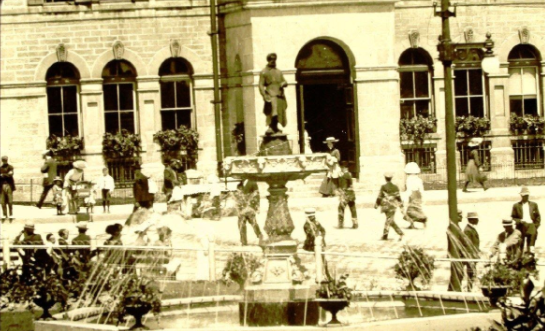The Blacksmith has witnessed a lot of Guelph history.
The statue that now stands in Priory Park on Macdonell Street across from Guelph Central Station presided over St. George’s Square for thirty-seven years. The Blacksmith saw the city centre evolve from the hub of an agricultural community to that of a booming industrial town. Dirt streets were paved. Cars replaced horse-drawn buggies. Wooden buildings gave way to structures of brick and stone.
Parades celebrating events like Empire Day and Labour Day streamed past The Blacksmith. So did the regiments of Guelph men who went to fight in the South African War and the First World War. Crowds of people surged around The Blacksmith to cheer returning soldiers.
The statue was then one of Guelph’s best-known landmarks. Guelphites like John McCrae and Edward Johnson would have been familiar with it. British-born journalist Hereward Cockin, who moved to Guelph and achieved minor literary fame with his epic poem “Dick o’ the Greys”, wrote a popular column for the Mercury under the pen name “The Blacksmith.”
But for all the drama that unfolded around him, The Blacksmith has had a colourful history of his own.
In 1885, manufacturer J.B. Armstrong gave the statue to Guelph as a symbol of the community’s industry. A rumour spread that he’d won it in a poker game in Chicago. A later story said that Prime Minister Sir John A. Macdonald had given Armstrong the statue. However, in 1987 Mary Mitchell, a researcher for the Local Architectural Conservation Advisory Committee, concluded that Armstrong bought the statue in New York City.
In the early 1870s, St. George’s Anglican Church had been moved from its original location on the town’s central square. After a few years, City Council decided that something was needed to provide a focal point in what was now an empty-looking space. The Blacksmith suited that purpose admirably.
The statue was 12 feet tall and weighed a ton. It was cast in zinc, and according to documentation, was bronzed. The right hand gripped a hammer. The statue was mounted on a cast-iron pedestal supported by a red granite base. The Blacksmith towered above a fountain that had goats’ heads spouting water. It was first turned on in 1885 in honour of Queen Victoria’s birthday.
Modernization brought an end to The Blacksmith’s glory days as a downtown focal point. In 1922, a plan to run a streetcar line straight through St. George’s Square saw The Blacksmith evicted and relocated to Priory Park. In 1960, the whole structure had to be moved to another part of the park when Macdonell Street was widened. The Blacksmith was painted silver and nicknamed The Silversmith. Then the statue became the target of an annual prank in which university students covered it in paint and tar.
Nonetheless, even in those dark days The Blacksmith usually had company. Working people sat around the fountain to have their lunch, and on hot summer days children played in the water. But over the years, The Blacksmith deteriorated.
In 1980, with the unveiling of the controversial sculpture “The Family” in St. George’s Square, some residents called for the return of The Blacksmith to the square. They felt the properly-attired figure would make it more of a “family place” than the nude figures of a man, a woman and a baby boy.
The Blacksmith never was returned to St. George’s Square, but a movement eventually got under way to have the statue restored.
In 1987, The Blacksmith was taken to a warehouse for repairs. By that time it was so dilapidated, some experts thought it would have to be completely re-cast. But Guelphites didn’t want a new Blacksmith; they wanted life breathed back into the original. So, the restoration crew went to work.
All the ravages of time, the elements and vandalism were dealt with. That included replacing missing fingers, and giving The Blacksmith tools of his trade; a long-handled mallet and a pair of tongs. Soon he was back on his pedestal, which had also undergone reconstruction. T
he Blacksmith was positioned so that he was facing the spot where John Galt had cut down the first tree when he founded Guelph in 1827. In 1988, The Blacksmith was designated an item of historical and architectural interest.
He stands today as a surviving landmark of old Guelph, surrounded by structures of the modern city.



